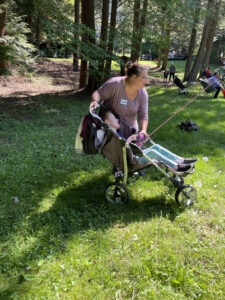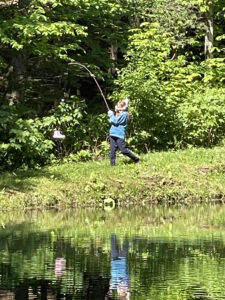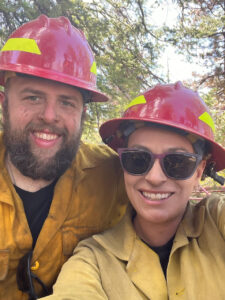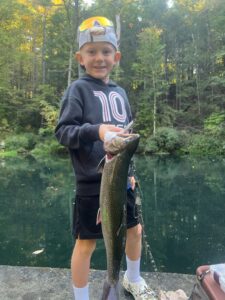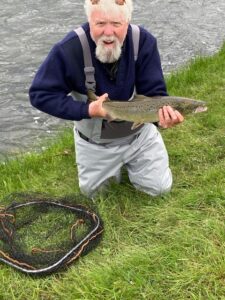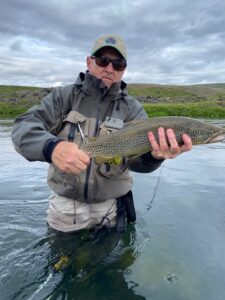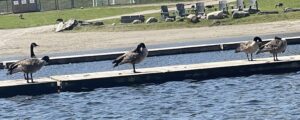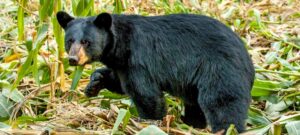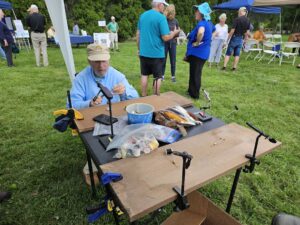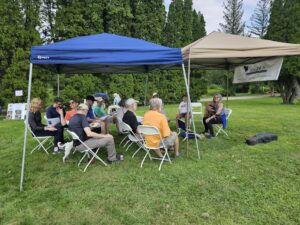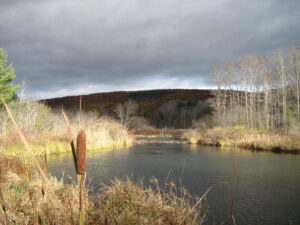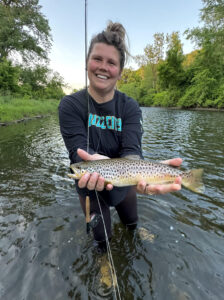MassWildlife has been approached to pause the stocking of trout in the Catch and Release area to give wild brown trout, which are not native in the proponent’s opinion, a better chance for survival. Others propose keeping the stocking as it has a major impact on the well being of many people who fish there and have businesses that depend on the success of the anglers. As a result, two public listening sessions regarding the management of trout in the Upper Deerfield River will be held via Zoom type platform on October 17, one at 1:00 p.m., the other at 6:00 p.m. It is important that all constituents participate so that the Fish & Wildlife Board gets as broad as possible opinions.
This subject was presented to the F&W Board back in March of this year. Apparently, it feels it is warranted to have a further discussion.
I contacted Attorney Kevin Parsons, one of the presenters at the session, regarding his concerns about stocking over a significant wild trout population in the Upper Deerfield River (defined as from Route 2 bridge near Mohawk Park in Charlemont up to Fife Dam…..being about 7.5 miles of river). His response was as follows:
“The compelling reason why the stocking needs to stop ASAP is to enable the gathering of additional science to support even better flow regime enhancements when the Great River license comes up for renewal in 2037… yet that process starts in 2031-2032. At that time those who care about river ecology need to be prepared with science to demonstrate there is a need for additional studies which could be paid for by the license renewal applicant.” (Great River owns 4 facilities on the Deerfield upriver of Brookfield Power, and two below.)
“What I learned as a lead negotiator for the Deerfield River TU Chapter in the Federal Energy Regulatory Commission (FERC) relicensing of the Brookfield license over the last 10 years was unless you have science in hand to prove impact, FERC will thumb its nose at advocates request for more studies as there is no proven impact.” (Brookfield Power owns the Fife Dam and Bear Swamp Pump Storage)
“In our case we proved the current Brookfield hydropeaking operations were having a substantial impact on the spawning effort. This proved to be the deciding factor in our ability to secure winter flows we got from Brookfield from 125 cfs to 225 cfs. (Cubic feet of water per second). Although Brookfield has limited ability to mitigate winter flow deficiencies, Great River on the other hand has plenty of water in the upper reservoirs to have an even greater impact on river ecology. However, we need to show how the minimum flow enhancements are having on the wild fishery….and then make the case for even better winter flows. With the known impacts of stocked fish on the wild fish population, this science is impossible with so many stocked fish among the wild fishery. It is common sense that the thousands of fish being dumped into the Upper River are eating wild fry and young of year fish.”
“Fish biologists have informed us at least three years assessment of the wild fishery (free of stocking) must be conducted prior to the anticipated increase in minimum winter flows. Then 3-4 years after the enhanced flows. Then we will know for sure what the wild fishery is and whether or not it will prove itself to be as substantial as we believe it will be…if the stocking stops and the flows are such that wild fish recruitment rebounds with the winter flows covering the redds.”
“The story is not whether pellet raised fish are good for anglers. It is about whether we can gather the science over the next 7 years or so to demonstrate that we have a wild fishery warranting protection. We believe without stocking the wild fishery will, even without the flow adjustments, take hold. And then with the negotiated minimum flow enhancements it will even become what we believe is an amazing wild fishery that we all could be proud of having in our back yard. It already exists in the Dry Way just upriver of the Brookfield impoundment so why not in this 7-mile section?”
“A Trout Unlimited study review of over 110 international studies on stocking over wild and native fisheries was clear…. it is bad. Vermont, New Hampshire, and Maine anglers have resoundedly supported the enhancement of wild and native fisheries. Massachusetts is the only New England state that does not have a wild fish management policy. Vermont does and 75% of the anglers up there supported the cessation of stocking over known significant wild/native fisheries. With Massachusetts biodiversity policy and mandate from MassWildlife recently adopted, this fits right in to that effort. Stocking over wild fish does not.”
I reached out to MassWildlife to comment on this matter. Their response was, “MassWildlife considers the Deerfield River to be one of the most important cold-water fisheries in the state. It is a premier destination for anglers throughout Massachusetts and New England. Trout fishing in the Deerfield has become a year-round activity supporting several guide services and bringing business to rural Franklin County communities.”
“The river and surrounding watershed also benefit from passionate advocacy from anglers and other conservationists who care deeply about the resource. MassWildlife’s current management of the upper Deerfield River includes the stocking of rainbow trout to supplement a low-density but sustainable wild brown trout fishery.”
Recognizing the importance of the Deerfield River fishery to the broader angling public, the F&W Board is seeking feedback on this request at the two above mentioned public listening sessions.
Currently, MassWildlife stocks 12–16” rainbow trout throughout the Deerfield River including in the upper reach below Fife Brook Dam. Stocked rainbow trout are incredibly popular with anglers in the Deerfield River, as volunteer angler surveys indicate that rainbow trout represent 69% of the catch in the upper Deerfield. These fish have long been a target of recreational anglers of all levels looking for a tailwater fishing experience. Eliminating rainbow stocking would have a significant impact on the quality of angling.”
“MassWildlife biologists have been closely studying the upper Deerfield since 2019, assessing the fish community, including stocked and wild reproducing brown trout. MassWildlife has seen no evidence to indicate predation or competition between stocked rainbow trout and wild brown trout in the upper Deerfield. MassWildlife’s fisheries community assessments show ample food resources including invertebrates available for stocked rainbows to eat. This abundance of available prey and habitat makes direct competition for food or space with wild brown trout unlikely.”
“As a result, MassWildlife expects that halting the stocking of rainbow trout would offer minimal ecological advantages for wild brown trout while significantly reducing the quality of the fishing experience for many anglers.”
“MassWildlife is committed to continuing to use research and the best available science to inform its management decisions, including when, where, and how the Deerfield River is stocked in the future.”
So there you have it. Instructions for joining the session can be found by visiting Mass.gov/dfw/calendar.
Fall Trout Stocking
The fall stocking of trout should be completed by this weekend. The following waters should have been stocked: Stockbridge Bowl, Onota Lake, Pontoosuc Lake, Lake Buel, Goose Pond, Laurel Lake, North Pond, Windsor Lake, Windsor Pond, Otis Reservoir, Richmond Pond, Ashfield Lake, and the Deerfield River. We still need some serious rain to raise the water level in the East Branch of the Westfield River, and if we don’t get it, then it is doubtful that it will be stocked this fall.
Hunting seasons opening this upcoming week
The regular goose hunting season in the Berkshires opens on October 14 and runs through November 16. It shuts down through the shotgun deer hunting season and then reopens December 11 through December 14.
Pheasant hunting season opens on October 19 and runs to December 31. Ruffed Grouse (partridge) season opens on October 19 and runs to November 30. Cottontail rabbit and snowshoe hare hunting seasons open on October 19 and end on February 28, 2025.
F&W Board elections
The Fish & Wildlife Board conducted its annual officer elections at its October 2 Meeting. By unanimous vote the following were chosen: Stephen Sears of Dalton, was re-elected Chairman, Emma Ellsworth of Orange was elected Vice Chair replacing Robert Durand of Marlborough, who decided to step down. Ernest Foster of Scituate was re-elected Secretary.

